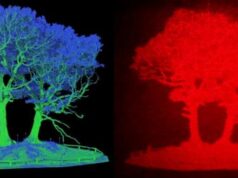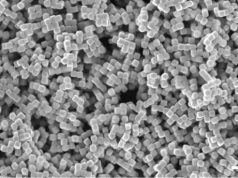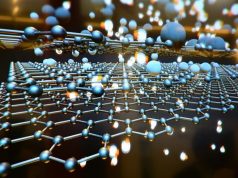Sila Kiliccote, head of SLAC’s GISMo (Grid Integration, Systems and Mobility) lab, and Stanford graduate student Gustavo Cezar look at a computer dashboard showing how appliances, batteries, lighting and other systems in a “home hub” network could be turned on and off in response to energy prices, consumer preferences and demands on the grid. The lab is part of the Bits & Watts initiative. Credit: SLAC National Accelerator Laboratory
Research Program Combines Silicon Valley Technology with Industry and Regulatory Expertise
To stave off the worst effects of global warming, energy experts say society needs to switch to low-carbon, inexpensive energy sources like wind and solar on a massive scale. But it will be a challenge to add large numbers of these variable sources to today’s electric grid without throwing it off balance and triggering potential outages.
An initiative called “Bits & Watts”, launched today by Stanford University and the U.S. Department of Energy’s SLAC National Accelerator Laboratory, aims to solve that problem by developing “smart” technology that will bring the grid into the 21st century while delivering reliable, efficient, affordable power to homes and businesses.
The interdisciplinary initiative will also go beyond technology to develop market structures, regulatory frameworks, business models and pricing mechanisms that are crucial for making the grid run smoothly. It brings together SLAC technical experts with Stanford experts in business, law and engineering, and will work with industry and policymakers to identify and solve problems that stand in the way of grid modernization.
“The first challenge was to bring down the cost of wind, solar and other forms of distributed power. The next challenge is to create an integrated system,” said Steven Chu, a Stanford professor, Nobel laureate and former U.S. Energy Secretary and one of the founding researchers of Bits & Watts. “We must develop the right technologies, financial incentives and investment atmosphere to take full advantage of the lowering costs of clean energy.”
Expanding and Tuning a Finely Balanced Machine
Find your dream job in the space industry. Check our Space Job Board »
The U.S. electric grid is actually two giant, continent-spanning networks, plus a third, smaller network in Texas, that connect power sources and consumers via transmission lines. Each network runs like a single machine, with all its parts humming along at the same frequency, and their operators try to avoid unexpected surges and drops in power that could set off a chain reaction of disruptions and even wreck equipment or hurt people.
“Today’s electric grid is one of the greatest engineering achievements of the 20th century and the lifeblood of the modern economy. But it’s also an incredibly complex and finely balanced ecosystem that’s designed to handle power flows in only one direction – from centralized power plants to the consumer,” said Arun Majumdar, a Stanford professor of mechanical engineering who co-directs both Bits & Watts and the university’s Precourt Institute for Energy, which oversees the initiative.
“As we incorporate more low-carbon, highly variable sources like wind and solar – including energy generated, stored and injected back into the grid by individual consumers – we’ll need a whole new set of tools, from computing and communications to controls and data sciences, to keep the grid stable, efficient and secure and provide affordable electricity,” Majumdar said.
“Technology has enabled many new options for how people get their electricity,” said Frank Wolak, a Stanford economics professor and the other co-director of Bits & Watts. “Deploying the least-cost mix of these technologies to meet the needs of current and future electricity consumers will require new wholesale and retail market mechanisms and new regulations. A research effort involving engineers, social scientists and legal scholars, as Bits & Watts is doing, is essential to achieve this goal.”
Simulating the Grid in the Lab
The initiative includes two labs connected via the cloud at Stanford and SLAC where researchers will develop ways to use digital sensors and controls to collect data from millions of sources, from rooftop solar panels to electric car charging stations, wind farms, factory operations and household appliances and thermostats, and provide the real-time feedback grid operators need to seamlessly incorporate variable sources of energy and automatically adjust power distribution to customers.
Both the SLAC and Stanford labs will begin to incorporate groups of homes and commercial buildings into their data gathering and simulations starting in 2017 to test software and hardware in development.
“Bits & Watts will offer a trusted, unbiased and highly technical source of analysis, expertise and data, and it will develop ways that we can share data without compromising privacy, security or confidentiality,” said Sila Kiliccote, a SLAC staff scientist and head of SLAC’s Grid Integration, Systems and Mobility (GISMo) lab.
Industry will play an important role in the program, from contributing funding and equipment to sponsoring cooperative research. The program will offer education and training to power industry executives, as well as to Stanford undergraduate and graduate students.
All of the grid-related software developed by Bits & Watts will be open source, so it can be rapidly adopted by industry and policymakers and used by other researchers.
Real-time Improvements Based on Vast Amounts of Data
The initiative includes research projects that will:
-Simulate the entire smart grid, from central power plants to networked home appliances (Virtual Megagrid).
-Analyze data on electricity use, weather, geography, demographic patterns, and other factors to get a clear understanding of customer behavior via an easy-to-understand graphical interface (VISDOM).
-Develop a “home hub” system that controls and monitors a home’s appliances, heating and cooling and other electrical demands and can switch them on and off in response to fluctuating electricity prices, demands on the power grid and the customer’s needs (Powernet).
-Gather vast and growing sources of data from buildings, rooftop solar modules, electric vehicles, utility equipment, energy markets and so on, and analyze it in real time to dramatically improve the operation and planning of the electricity grid (VADER). This project will incorporate new data science tools such as machine learning, and validate those tools using data from utilities and industry.
-Create a unique data depository for the electricity ecosystem (DataCommons).
Said SLAC Laboratory Director Chi-Chang Kao, “SLAC and Stanford, in cooperation with industry and electricity system stakeholders, will rise to the challenges of building a modern grid that will make a clean energy future possible.”
Through the Grid Modernization Initiative, initial Bits & Watts projects are being funded for a combined $8.6 million from two DOE programs, the Advanced Research Projects Agency-Energy (ARPA-E) and the Grid Modernization Laboratory Consortium; $2.2 million from the California Energy Commission; and $1.6 million per year from industrial members, including China State Grid, PG&E (Pacific Gas & Electric), innogy SE (formerly RWE), Schneider Electric and Meidensha Corp.











